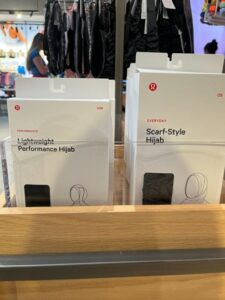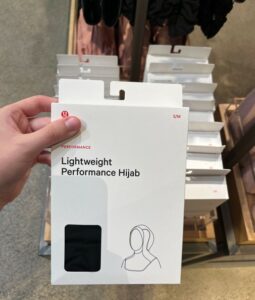Lululemon Answers Call from Inclusivity-Minded Consumers; Early Take on Lululemon’s DEI Product Expansion
Since the founding of Lululemon in 1998, the rise of athletic apparel, or “athleisure” has been redefining the fashion industry. Lululemon continues to innovate within many product categories, including women’s and men’s apparel and accessories for yoga, training, running, on-the-move (OTM), and “woman-first” footwear. Joining Nike, Adidas and Under Armour, Lululemon now offers an exciting and inclusive choice in athletic apparel: hijabs.
Lululemon Plays Catch up with DEI (Diversity, Equity and Inclusion) Efforts
Inclusive practices have long been at the heart of Lululemon’s competitors, such as mission-driven companies like Girlfriend Collective and increasingly DEI-centric players like Athleta and Nike. Lululemon recognized its imperfect history with diversity and inclusion and has since made significant strides forward under the leadership of VP Stacia Jones, Global Head of Inclusion, Diversity, Equity, and Action (IDEA). These efforts span from implementing equitable hiring practices to increasing representation in the ambassador program and are especially important to their strategic targeting of older Gen Z’s and younger Millennials. Lululemon’s target audience is heavily influenced by business ethics, standpoints, and practices. For example, a 2020 study from Quantilope found that more than 7 in 10 target consumers (76% of Gen Z and 72% of Millennials) believe diversity and inclusion are important compared to less than half of Boomers. Activist consumerism within this age range is supported by our proprietary study “Consumer Trust in the Time of COVID.” We found that roughly half of Gen Z and Millennial consumers agreed with the statement “finding a retailer whose values align with my own is critical to choosing where I shop” relative to only about a third of Baby Boomers.
Consumers Welcome Lululemon’s Hijabs, with Some Caveats
Initial market feedback from the rollout of Lululemon’s athletic hijabs has leaned positive. The company received high praise on LinkedIn for putting inclusiveness into action. Many hijab wearers in the global influencer and ambassador community also took to LinkedIn to share how proud they were to be part of the design creation. However, reviews on Lululemon’s website for these product offerings are largely mixed.

Photo Credit: Lululemon
For the Lightweight Performance Hijab, only half of the reviews to date offer 5 stars, with lower marks often attributed to the choice of material and design aesthetic (such as limited colorways across both designs offered today).

Photo Credit: Lululemon
Despite this, reviewers tend to prefer the Lightweight Performance Hijab compared to the Scarf-Style Hijab due to its lightweight and sweat-wicking features compared to the scarf style’s thick and heavy material.

Photo Credit: McMillanDoolittle
Lululemon’s In-store Display of Hijabs is a Step in the Right Direction
The hijabs are strongly positioned as the first accessories visitors see upon entering Lululemon’s Experiential Store in Chicago. Unlike other accessories in the accessory display, customers are not required to stand in line to access these products.

Photo Credit: McMillanDoolittle
The prominent display of this new product to unsuspecting hijab-wearers visiting the store essentially recreates the pleasant surprise that online reviewers described upon discovering this new product that reaches their underserved community. The intentional forward placement undoubtedly raises awareness of Lululemon’s DEI efforts for non-wearers as well as an appeal to its ethics-driven target market. It’s worth noting that unlike other headwear, such as hats or headbands, the hijabs are the only accessory placed within a box – perhaps another intentional product design detail attributed to the cultural significance of the hijab and the intention of respect. An alternative option is to maintain the packaging and put the hijabs on display as the current choice prevents customers from viewing differences in sizes, textures, and other important styling details that do not come to life today in the store.

Photo Credit: McMillanDoolittle
Inclusive Practices Become Table Stakes Success in Fashion
Lululemon is known to have a following of highly engaged and loyal customers. The retailer recognized a gap between what a guest might need and what solutions they currently offer compared to their competitors. Had Lululemon been more strategic when it came down to the execution of the product and its packaging, the hijab category launch may have been more successful. However, this is a good example of a large retailer paying attention to what their target market wants and designing something that they believe will enhance the lives of their customers. By recognizing the diversity of its target audience, Lululemon is making progress in its work as a retailer that is committed to diversity and inclusion, furthering its status with Gen Z and Millennials.
If you enjoyed this article on Lululemon’s entry into hijabs, please reach out to us with any questions regarding product expansion strategies as well as ways to make your product line more inclusive. To stay up to date on our latest retail insights, keep up with our blog, check out our Instagram feed and stories, and follow us on LinkedIn.

No Comments